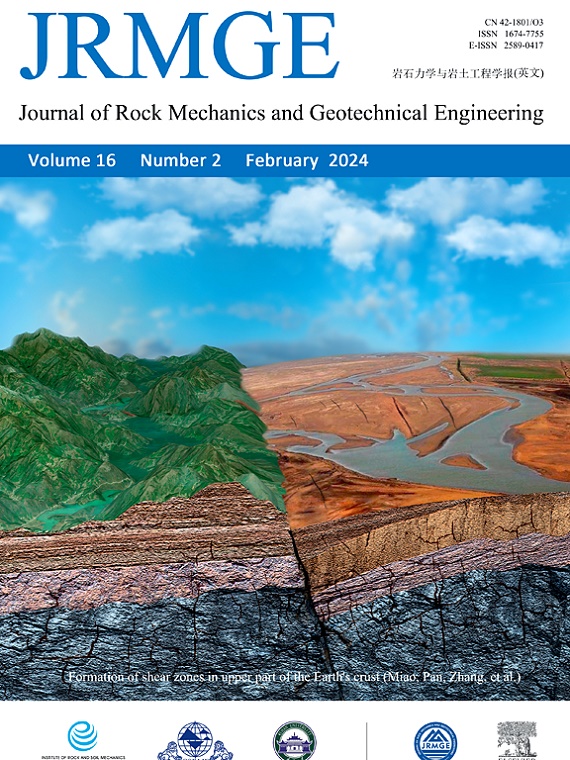Three-dimensional finite element simulation and reconstruction of jointed rock models using CT scanning and photogrammetry
IF 10.2
1区 工程技术
Q1 ENGINEERING, GEOLOGICAL
Journal of Rock Mechanics and Geotechnical Engineering
Pub Date : 2023-11-01
DOI:10.1016/j.jrmge.2023.08.008
引用次数: 0
Abstract
The geometry of joints has a significant influence on the mechanical properties of rocks. To simplify the curved joint shapes in rocks, the joint shape is usually treated as straight lines or planes in most laboratory experiments and numerical simulations. In this study, the computerized tomography (CT) scanning and photogrammetry were employed to obtain the internal and surface joint structures of a limestone sample, respectively. To describe the joint geometry, the edge detection algorithms and a three-dimensional (3D) matrix mapping method were applied to reconstruct CT-based and photogrammetry-based jointed rock models. For comparison tests, the numerical uniaxial compression tests were conducted on an intact rock sample and a sample with a joint simplified to a plane using the parallel computing method. The results indicate that the mechanical characteristics and failure process of jointed rocks are significantly affected by the geometry of joints. The presence of joints reduces the uniaxial compressive strength (UCS), elastic modulus, and released acoustic emission (AE) energy of rocks by 37%–67%, 21%–24%, and 52%–90%, respectively. Compared to the simplified joint sample, the proposed photogrammetry-based numerical model makes the most of the limited geometry information of joints. The UCS, accumulative released AE energy, and elastic modulus of the photogrammetry-based sample were found to be very close to those of the CT-based sample. The UCS value of the simplified joint sample (i.e. 38.5 MPa) is much lower than that of the CT-based sample (i.e. 72.3 MPa). Additionally, the accumulative released AE energy observed in the simplified joint sample is 3.899 times lower than that observed in the CT-based sample. CT scanning provides a reliable means to visualize the joints in rocks, which can be used to verify the reliability of photogrammetry techniques. The application of the photogrammetry-based sample enables detailed analysis for estimating the mechanical properties of jointed rocks.利用CT扫描和摄影测量技术对节理岩石模型进行三维有限元模拟和重建
节理的几何形状对岩石的力学性能有重要影响。为了简化岩石中的弯曲节理形态,在大多数室内实验和数值模拟中,节理形态通常被视为直线或平面。本研究采用计算机断层扫描(CT)和摄影测量法分别获得石灰石样品的内部和表面节理结构。为了描述节理的几何形状,应用边缘检测算法和三维矩阵映射方法重建基于ct和基于摄影测量的节理岩石模型。为了进行对比试验,采用并行计算方法对完整岩样和简化为平面的节理岩样进行了数值单轴压缩试验。结果表明,节理岩石的力学特性和破坏过程受节理几何形状的显著影响。节理的存在使岩石的单轴抗压强度、弹性模量和声发射能量分别降低37% ~ 67%、21% ~ 24%和52% ~ 90%。与简化的节理样本相比,本文提出的基于摄影测量的数值模型充分利用了节理有限的几何信息。实验发现,基于摄影测量的样品的声发射强度、累积释放声发射能量和弹性模量与基于ct的样品非常接近。简化节理试样的UCS值(38.5 MPa)远低于ct基试样的UCS值(72.3 MPa)。简化节理试样的声发射累计释放能比基于ct的试样低3.899倍。CT扫描提供了一种可靠的手段来可视化岩石中的节理,这可以用来验证摄影测量技术的可靠性。应用基于摄影测量的样品可以对节理岩石的力学特性进行详细的分析。
本文章由计算机程序翻译,如有差异,请以英文原文为准。
求助全文
约1分钟内获得全文
求助全文
来源期刊

Journal of Rock Mechanics and Geotechnical Engineering
Earth and Planetary Sciences-Geotechnical Engineering and Engineering Geology
CiteScore
11.60
自引率
6.80%
发文量
227
审稿时长
48 days
期刊介绍:
The Journal of Rock Mechanics and Geotechnical Engineering (JRMGE), overseen by the Institute of Rock and Soil Mechanics, Chinese Academy of Sciences, is dedicated to the latest advancements in rock mechanics and geotechnical engineering. It serves as a platform for global scholars to stay updated on developments in various related fields including soil mechanics, foundation engineering, civil engineering, mining engineering, hydraulic engineering, petroleum engineering, and engineering geology. With a focus on fostering international academic exchange, JRMGE acts as a conduit between theoretical advancements and practical applications. Topics covered include new theories, technologies, methods, experiences, in-situ and laboratory tests, developments, case studies, and timely reviews within the realm of rock mechanics and geotechnical engineering.
 求助内容:
求助内容: 应助结果提醒方式:
应助结果提醒方式:


